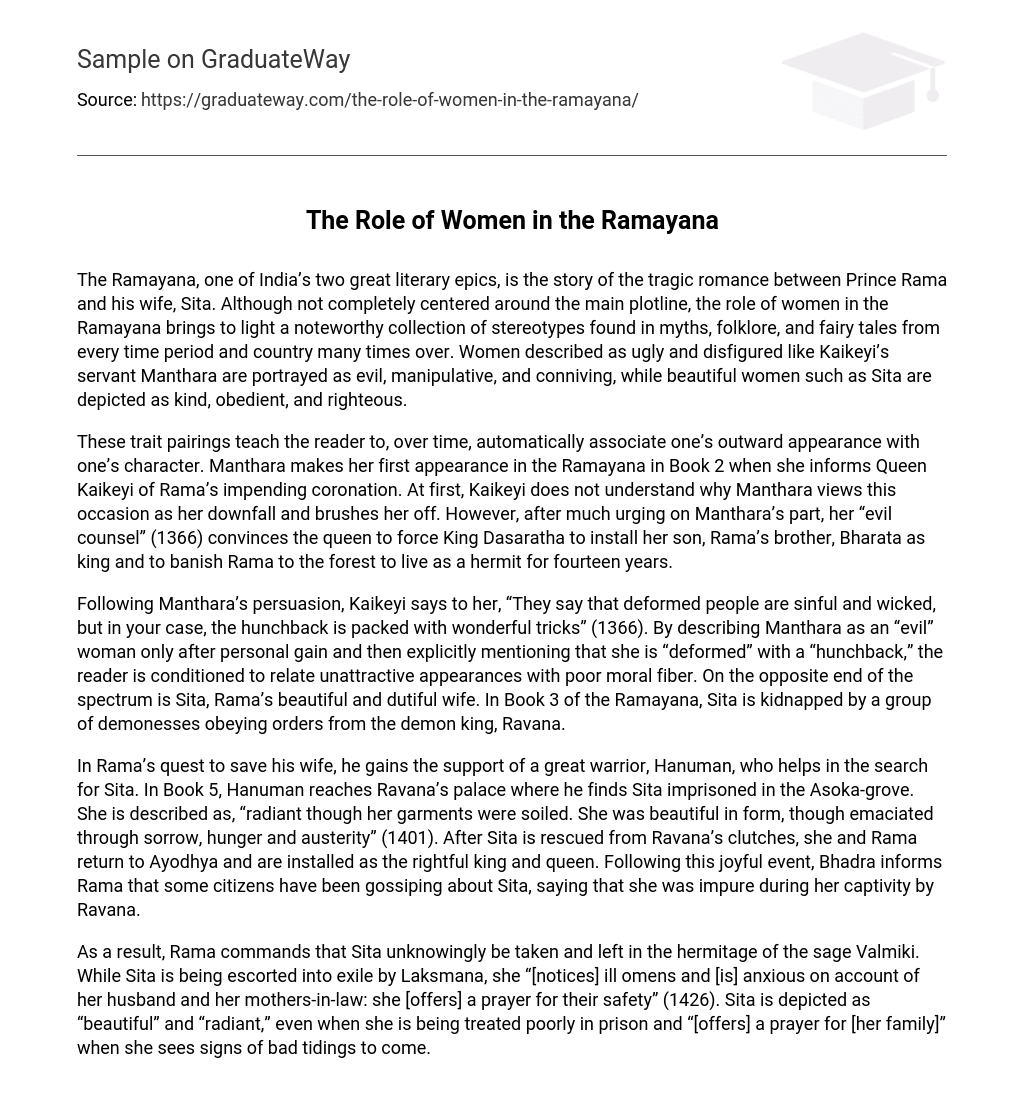The Ramayana, one of India’s two great literary epics, is the story of the tragic romance between Prince Rama and his wife, Sita. Although not completely centered around the main plotline, the role of women in the Ramayana brings to light a noteworthy collection of stereotypes found in myths, folklore, and fairy tales from every time period and country many times over. Women described as ugly and disfigured like Kaikeyi’s servant Manthara are portrayed as evil, manipulative, and conniving, while beautiful women such as Sita are depicted as kind, obedient, and righteous.
These trait pairings teach the reader to, over time, automatically associate one’s outward appearance with one’s character. Manthara makes her first appearance in the Ramayana in Book 2 when she informs Queen Kaikeyi of Rama’s impending coronation. At first, Kaikeyi does not understand why Manthara views this occasion as her downfall and brushes her off. However, after much urging on Manthara’s part, her “evil counsel” (1366) convinces the queen to force King Dasaratha to install her son, Rama’s brother, Bharata as king and to banish Rama to the forest to live as a hermit for fourteen years.
Following Manthara’s persuasion, Kaikeyi says to her, “They say that deformed people are sinful and wicked, but in your case, the hunchback is packed with wonderful tricks” (1366). By describing Manthara as an “evil” woman only after personal gain and then explicitly mentioning that she is “deformed” with a “hunchback,” the reader is conditioned to relate unattractive appearances with poor moral fiber. On the opposite end of the spectrum is Sita, Rama’s beautiful and dutiful wife. In Book 3 of the Ramayana, Sita is kidnapped by a group of demonesses obeying orders from the demon king, Ravana.
In Rama’s quest to save his wife, he gains the support of a great warrior, Hanuman, who helps in the search for Sita. In Book 5, Hanuman reaches Ravana’s palace where he finds Sita imprisoned in the Asoka-grove. She is described as, “radiant though her garments were soiled. She was beautiful in form, though emaciated through sorrow, hunger and austerity” (1401). After Sita is rescued from Ravana’s clutches, she and Rama return to Ayodhya and are installed as the rightful king and queen. Following this joyful event, Bhadra informs Rama that some citizens have been gossiping about Sita, saying that she was impure during her captivity by Ravana.
As a result, Rama commands that Sita unknowingly be taken and left in the hermitage of the sage Valmiki. While Sita is being escorted into exile by Laksmana, she “[notices] ill omens and [is] anxious on account of her husband and her mothers-in-law: she [offers] a prayer for their safety” (1426). Sita is depicted as “beautiful” and “radiant,” even when she is being treated poorly in prison and “[offers] a prayer for [her family]” when she sees signs of bad tidings to come. In doing this, the reader cannot help but assume that aesthetic beauty is indicative of kindness and purity.
While the Ramayana is most concerned with the escapades of Prince Rama, his kingdom, and his wife, the epic also exists as another example of how beautiful women are portrayed as good, and ugly women are depicted as bad, as evidenced by the characters Sita and Manthara. Since this is a common practice in literature and media, even in modern times, it would be curious to learn if people apply this habit in everyday occurrences: judging a defendant in court, hiring an employee, or tipping a server.





